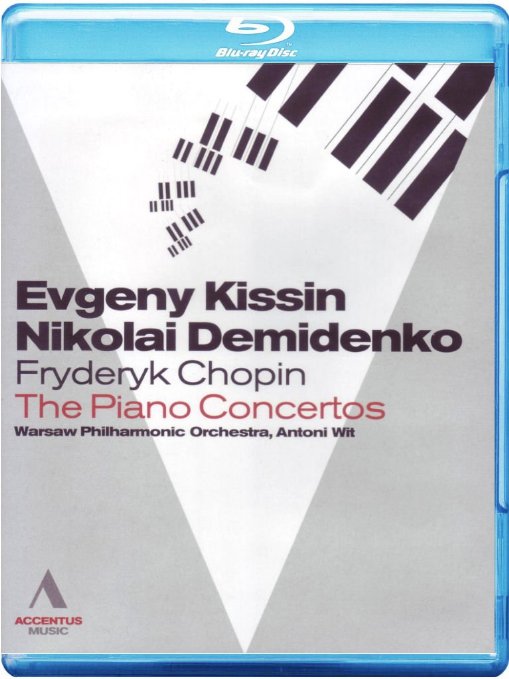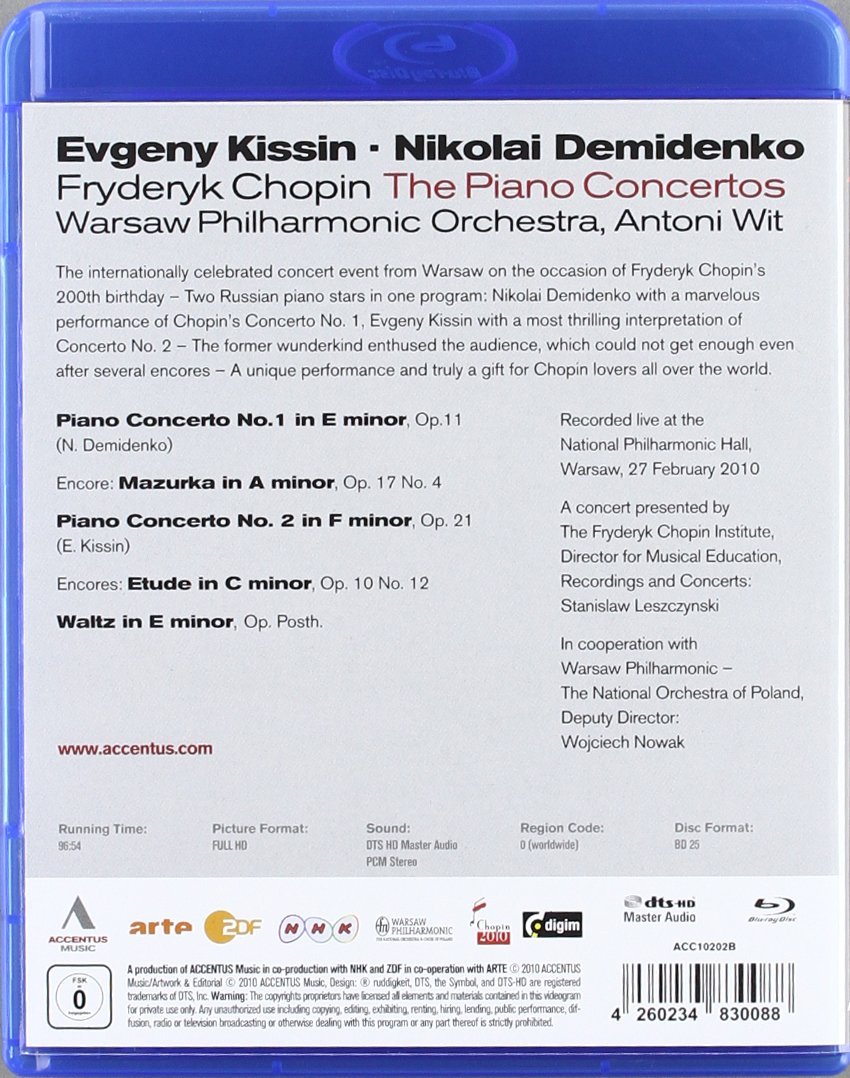

This 2010 Chopin Concerts program has the following music:
Nikolai Demidenko plays the Chopin Concerto No. 1
Demidenko plays as encore the Chopin Mazurka in A minor
Evgeny Kissin follows with the Chopin Concerto No. 2
Kissen plays as encore the Chopin Etude in C minor
Kissen plays as second encore the Chopin Waltz in E minor
Antoni Wit conducts the Warsaw Philharmonic Orchestra at the Warsaw Philharmonic Hall. Directed for TV by Michael Beyer. Released 2011, disc has 5.1 dts-HD Master Audio sound. For both performances, Grade: B
There are interesting shots of the Warsaw Philharmonic Hall and a surprisingly casual, young, and cosmopolitan-looking audience. This title bears the Paul Smaczny stamp — an event as well as a musical performance. Both of these famous soloists turn in A to A+ work, but their efforts are dragged down by weak SQ, weak PQ, and disastrous video content.
This disc has fine and clear sound recording of the piano. But the orchestra sounds thin, flat, and washed out. When the brass comes in, there is a muddy, chaotic effect. Picture resolution is soft.
Piano Concerto No. 1
Demidenko — self-effacing, bemused, and under-dressed — quietly turns out what seems to us to be an excellent performance. Other reviewers have called him "timid" or "cautious." But we think he is performing the music as Chopin did. Here are words of pianist Byron Jaris that appeared years ago in the Wall Street Journal:
“Chopin's physical strength was limited not only by his delicate physique, but by his battle with tuberculosis. As a result, many who heard him perform in public auditoriums complained that his tone was almost inaudible. Yet genius that he was, he found a way to handle and transcend his limitations. He devised a tonal palette scaled down to the softest sound possible, increasing to a mezzo forte (half-loud) that sounded like a fortissimo by way of contrast. Like the man, Chopin's music was a mystery. Nothing like it had ever been heard before, nor has it been since. Liszt would introduce Chopin to friends with words that captured that otherworldly quality: "I want you to meet a man who comes form another planet."
We think the poetic power of the Demidenko performance here puts him on that "other planet" with Chopin. Even though there are 3 movements, Demidenko plays the first note as the beginning of one long singing line that ends on the last note of the last bar. And there is one climax in his concerto (at the end of the first movement about halfway through the whole piece).
Piano Concerto No. 2
Kissin — resplendent and neurotic — goes for the kill. He succeeds with the girls for sure. He and Demidenko make a good pairing with their contrasting styles. Kissen's approach here is flash and slash, but done with great accuracy and and in good taste. However, he played his Etude encore so fast, it seemed more a stunt than a performance.
But now we must turn to the problems with video content. See our special story on standards for HDVD video of a symphonic orchestra recording. The essence of an HDVD recording is that it shows the entire orchestra as the default and moves in for closeup shots only where warranted. But in this entire video, there is exactly one whole orchestra shot and 3 part-orchestra shots, all of which last only a few seconds. The rest of both videos is a typical "road runner" race of innumerable close-ups of the star soloist and small groups of orchestra players — the hallmark of the disease we call DVDitis. We recently did a Wonk Worksheet of this. Both videos flunk 3 of the 4 video content tests explained in our special story mentioned above.
So how to we grade this? We start with an A+ performance. Lack of 96kHz/24-bit sound sampling brings us to a A. The recording of both concertos funks all our tests for DVDitis other than the conductor test. Reducing the grade for each concerto 1 letter for each failed test puts us at a D for both concertos. But it's rare to have a recording with two such esteemed piano soloists. Their efforts are satisfying, so we yank the grade back up to C+. If you forgive the publishers for not having 96kHz/24-bit sound sampling, the grade would be B.
OR
